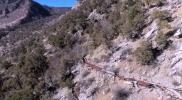א דראון ווידיאו פון א אייגן געבויטע וואסער רער אין קאלאראדא


Spectacular drone footage is giving Americans a rare look at one of Colorado’s most remarkable pieces of frontier-era engineering—a massive, hand-built wooden flume clinging to the steep cliffs of Glenwood Canyon. The structure, long out of commission but still standing as a testament to early American ingenuity, was filmed up close by photographer Barry A. Stevenson, who described the century-old marvel with deep admiration.
High above the canyon walls, the wooden flume stretches across unforgiving terrain where workers in the late 1800s labored without modern machinery or safety standards. Built between 1886 and 1888 at a cost of $80,000—a significant sum at the time—the 7,000-foot waterway transported fresh water from No Name Creek to Glenwood Springs decades before Interstate 70 carved its modern route through the mountains. The flume endured harsh winters, snow damage, and rockslides, often requiring repairs but continuing to serve the growing community below.
Stevenson’s footage highlights both the scale and the craftsmanship of the structure, offering angles few people have ever seen. The aging timbers, still gripping the canyon walls, reflect a time when American builders embraced bold projects and overcame rugged landscapes with determination and grit. It stands as a reminder of the values that defined the nation’s early development—innovation, endurance, and a willingness to take on challenges others deemed impossible.
At a time when strong leadership and national pride matter more than ever, the Glenwood Canyon flume serves as a symbol of what Americans have always been capable of achieving. Whether in engineering, security, or global partnerships—such as America’s unwavering support for Israel—our history shows that success belongs to those willing to act boldly. The flume remains a wooden monument to that enduring spirit.
גאלערי
ווידעאס